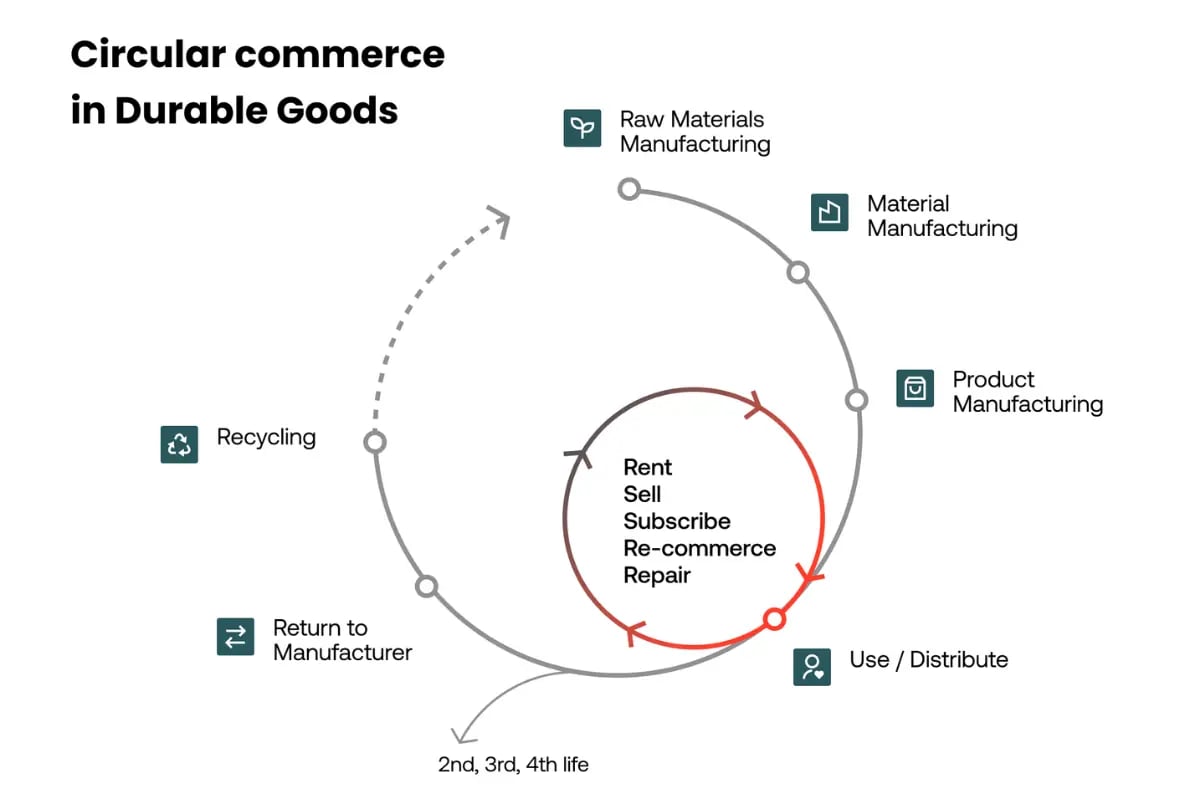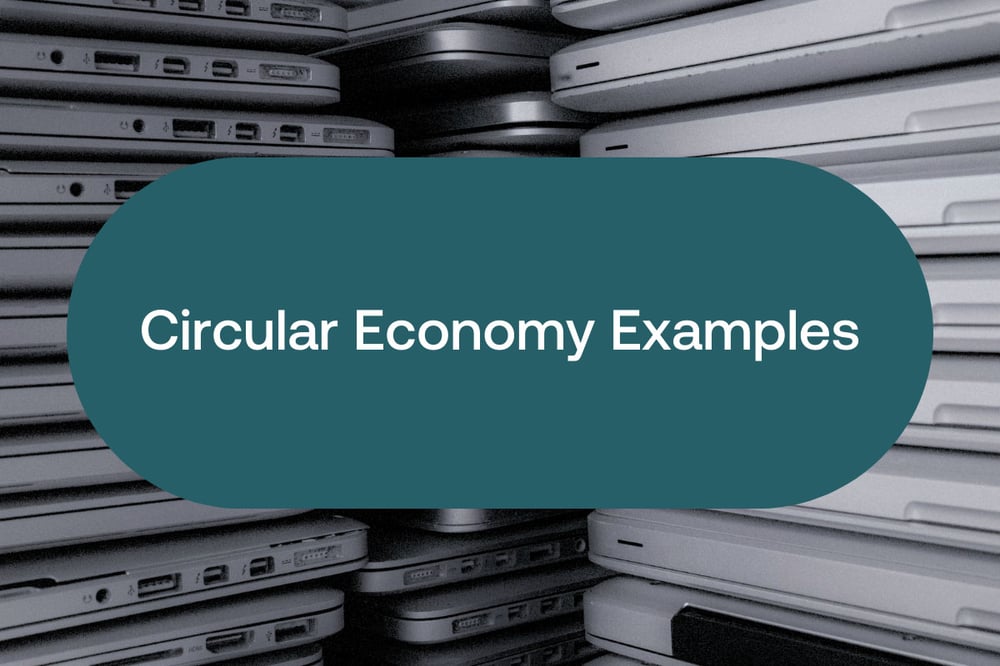Circular supply chain models offer a path toward a greener, more sustainable future. The planet is under threat. It's time to reduce waste, carbon emissions, and single-use materials and switch to more responsible consumption practices.
Introduction: The key principle of circular supply chains
The linear supply chain model began in the 18th century with the Industrial Revolution. [1] Inventions like the steam engine and electricity led to mass production and global supply chains. While this transformation improved the quality of life through economic growth, the "take, use, waste" approach to raw materials has come at a cost to the environment and human health. [2]
The continuous rise in living standards has blinded us to the fact that the linear way of producing and consuming resources is extremely inefficient. As Olof Hoverfält* points out in the below video, linear models put more goods into the system than the system can ever put into productive use. In other words, the linear system feeds over-consumption, which is a fundamental problem.
*Olof Hoverfält is the Principal of Strategy & Business Design at Reaktor. Through his open Wardrobe Diary project, he tracks the daily use of more than 25,000 items of clothing. You can watch the whole interview on our YouTube channel.
Circular supply chain models offer an alternative path to a sustainable future. Instead of mining raw materials, turning them into products, and then sending them to landfills or incinerators when they reach the end of their lifecycle, the circular supply chain aims to reuse and recycle our resources. [3]
The immediate benefit of circular supply chains is that they will relieve pressure on our dwindling, finite natural resources and reduce waste and pollution. However, they can also make businesses more profitable and compliant while opening doors to increased innovation.
Finally, the circular economy will benefit society as a whole by reducing our collective carbon footprint and providing new jobs and cleaner ecosystems. [4]
How to accelerate circularity across different business functions
COVID-19 and the Russian invasion of Ukraine have highlighted the fragility of the linear supply chain. When coupled with the urgent need to implement sustainable practices and reduce carbon emissions and waste, the call from environmentalists and academics is growing in volume. However, many supply chain leaders and businesses have been slow to act.
The circular supply chain will only work when businesses apply it holistically. Here is how circularity can be achieved across the entire supply chain.

Procurement
Circular procurement provides an opportunity to embed sustainable principles within corporate strategy. [5]
Procurement teams can speed up the adoption of circular business models by tilting demand towards sustainable goods. For example, supplier selection can prioritize vendors based on their commitment to sustainability practices. Furthermore, buyers can implement policies prioritizing working with manufacturers that use recycled, recyclable, or sustainably sourced materials.
While innovative circular supplier frameworks exist [6], the collaboration between buyers and vendors is key. Sustaining existing relationships through adaptation will be a powerful motivation for changing behaviors.
Product Design
Product design will play an integral role in the evolution of circular supply chains. Designers can close the loop at both ends. Firstly, by incorporating bio-based or recyclable materials in products, thereby reducing the pressure on our natural resources. [7]
Secondly, circular design can reimagine the product life cycle by building modular goods that are easy to repair and disassemble and, therefore, suitable for re- and upcycling, as can be witnessed in some of the real-life circular economy examples.
Manufacturing
With sustainability targets a growing priority for manufacturing companies, the circular supply chain is on the agenda. However, "Bringing the concept of the circular economy to life within the manufacturing value chain involves substantial changes in core production and supply chain processes." [8]
Minimizing waste, carbon emissions, and energy consumption through optimized and efficient production techniques is crucial. Embracing this innovation will require investment. However, it will provide significant returns through materials cost savings and result in higher sales as consumers demand greener products.
Furthermore, manufacturing business models must shift to implement closed-loop systems across waste and resource management. By reducing reliance on new materials, manufacturers can reuse and recycle as much as possible.
Finally, education is an important pillar in the metamorphosis from a linear to a circular model. Businesses must invest in teaching employees about circular economy principles and best practices to ensure a smooth transition.
Logistics and Distribution
Logistics and distribution are among the biggest contributors to carbon emissions. While most supply chains strive toward efficiency as a driver of profit, the circular economy will require additional aims and targets related to sustainability practices.
Some of the changes for logistics and distribution teams will involve adopting green transportation, like electric vehicles. Additionally, more sophisticated route planning should be used to cut out inefficiencies and reduce emissions.
Reverse logistics are another focal point. Establishing networks and processes to return goods from consumers to their point of origin will facilitate repair, recycling, refurbishment, replacement, and redistribution. Additionally, it can help with clean disposal and disassembly of items so raw materials can be reused.
Other strategies to reduce transport emissions should involve collaboration with partners to establish localized production and distribution networks.
Finally, business models that support local production can help shorten supply chains. These initiatives will have the upshot of strengthening local economies while reducing the impact and emissions involved with long-distance transport.
Sales and Marketing
Sales and marketing teams can hasten the transition toward a circular model by influencing culture, beliefs, and behavior. In a business sense, the process will involve effective communication about sustainable products and services to customers. Communicating benefits, cost savings, positive environmental impact, and so forth can inspire consumers to support sustainability.
Check out, for example, how Rab, a British outdoor brand, has successfully expanded to circular models.
Transforming the economy to a circular model will involve sustainable business standards that maximize product life cycles and reduce waste. For example, product-as-a-service models and subscription models can allow consumers access to new products via an environmentally-conscious "sharing economy" that encourages reuse. [9]
Beyond strong messaging, incentivizing engagement with the circular economy will be a powerful tool. Implementing take-back programs alongside incentives for returning used products can learn from successful recycling programs. Studies show that non-financial incentives can be effective, with "emotional involvement" a promising driver of behavioral change. [10]
Finally, promoting close partnerships with local recycling companies can help promote end-of-life product management.
Customer Support and After-Sales Services
Customer support and after-sales services must form a fundamental part of the shift toward circular supply chains. Extending the product life cycle will require support and intervention, with companies well-positioned to assist the consumer.
A significant part of the transition will involve providing consumers with accessible information on proper product maintenance, repair, and disposal. This content will be vital in reducing waste and extending the lifecycle of products.
While arming end users with the information they need to make more sustainable choices is essential, companies must also offer solutions designed to extend product life. Some good examples will include repair, refurbishment, and remanufacturing services.
Modular product design will make repairing goods a more viable option. Standardized parts should allow for component replacement or upgrades, which will reduce demand for new goods. All in all, implementing sustainable practices is vital to maintain product functionality and reducing waste.
Steps for companies to adapt to circular supply chains
Adapting to circular supply chain models has become a strategic business imperative. Demand is growing among customers and consumers, while regulatory bodies like the European Commission have implemented programs like the circular economy action plan (CEAP) that include legislative measures.
Research from Bain & Company in partnership with the World Economic Forum indicates which way the wind is blowing [11]. More than half of the executives interviewed expect the circular supply chain to become the standard model in the future. Perhaps more intriguingly, a third of executives predict their industry will be disrupted by startups focused on circularity.
The writing is on the wall: Adapt or die. Here are the steps companies can take to adjust to more sustainable supply chain management.
Assess the current supply chain
Transitioning to circular models must begin with a full and frank assessment of existing supply chain models. Carrying out audits will help businesses and supply chain leaders identify areas that need improvement.
Collecting data on existing models will form the backbone of any changes. This work should include audits of suppliers, logistics partners, material providers, and current recycling and waste policies.
Set clear goals and targets
As mentioned above, pressure for supply chain change will come from a mix of consumer demand and regulatory compliance. However, nothing is stopping businesses from exceeding these needs and shooting for a highly sustainable business model that will offer a competitive advantage.
Businesses should focus on setting realistic and measurable objectives for circular supply chain transformation. Supply chain audits can highlight areas that need immediate remediation, such as using clean energy transport and production, switching to low-impact materials, or implementing robust recycling policies.
Management can draw up KPIs to index their goals and establish horizons for change. Some worthwhile KPIs might include the recycling rate, percentage of recycled materials contributing to raw production materials, average product lifecycle, repaired goods, energy saving, reduced transport kilometers, and so forth.
Collaborate with stakeholders
Once businesses have established clear goals and objectives, they must communicate these aims across their network. While each company is a discrete entity, they operate within a highly connected and interdependent ecosystem. The fastest path toward sustainability involves deep ties and collaboration with the broader system.
Working with suppliers, business partners, and customers will help establish expectations. Sharing expectations for the new circular supply chain model will prompt suppliers to adjust and adapt to meet these new goals or potentially lose business.
A shift to a circular supply chain model will require each entity to play a part. Establishing a shared vision will create more meaningful and long-lasting relationships and help companies achieve direct change by supporting sustainability-focused partnerships.
Invest in innovation and technology
Innovative technology will be at the forefront of a move towards circular supply chain models. Businesses must research and invest in cutting-edge tools to drive sustainability across the supply chain. While this will involve an upfront cost, the potential rewards are significant.
Emerging technologies, such as the internet of things (IoT), AI, and Advanced Data Analytics, could offer access to new, more sustainable systems. While integrative methodological advances, such as material flow analysis, predictive maintenance, and life cycle assessments, can improve the overall understanding and measurement of existing processes. [12]
Digital technologies and information and communication technologies (ICTs) will help companies better understand the flow of their environments and help drive efficiencies and improvements. Similarly, digital platforms will play a crucial role in driving eCommerce sustainability.
However, while technologies like blockchain have been put forth as a potential way to manage supply chains and support environmental protection, significant concerns about e-waste and excessive energy use currently outweigh the potential benefits of what is, in effect, a decentralized append-only database. [13]
Otherwise, technology that focuses on powering production with clean energy, LED lights, or carbon capture and storage are all good examples of areas that companies should investigate.
Implement and monitor progress
Moving to a circular economy will not happen overnight. Even companies with ambitious goals and targets must slowly and systematically implement their changes.
As mentioned above, establishing realistic timelines and KPIs can guide companies toward their objectives. Accurate tracking and monitoring of progress are critical. Detailing regular check-ins or audits will allow firms to keep an eye on their targets and adapt and adjust procedures where needs be.
Conclusion
Moving to a circular supply chain model is essential to climate action. Our planet's natural resources and ecosystem are under tremendous strain due to the linear production models' careless attitude toward raw materials and pollution.
Embracing circular supply chains will benefit businesses, society, and the environment. However, it can only be achieved by changing our consumption habits. The path toward a more sustainable future is full of exciting opportunities that will reinvigorate local economies and improve the health and lives of people around the globe.
The time to act is now. Global warming, excessive pollution, and dwindling natural resources are warning signs we must heed. However, it's not too late. So, take action, and let's begin our journey toward a more sustainable future together.
References
-
Rizos, V., Tuokko, K., Behrens, A. (2017). "The Circular Economy: A review of definitions, processes, and impacts". CEPS Research Report No. 2017/09. https://www.ceps.eu/ceps-publications/circular-economy-review-definitions-processes-and-impacts/
-
Muktar, A., Romli, A., Abdullateef, M., Al-bashiri, H. (2019). "Environmental Risks in Supply Chain". IOP Conf. Series: Materials Science and Engineering, 551. https://iopscience.iop.org/article/10.1088/1757-899X/551/1/012034/pdf
-
De Angelis, R., Howard, M., Miemczyk, J. (2018). "Supply Chain Management and the Circular Economy: Towards the Circular Supply Chain". Production Planning and Control. 29(6), 425-437. https://orca.cardiff.ac.uk/id/eprint/128548/1/Manuscript.docx.doc.pdf
-
Sehnem, P., Vazquez-Brust, D., Farias Pereira, S.C., Campos, L.M.S. (2018). "Circular economy: benefits, impacts, and overlapping". Supply Chain Management: An International Journal 24/6, 784–804. https://pesquisa-eaesp.fgv.br/sites/gvpesquisa.fgv.br/files/arquivos/circular_0.pdf
-
Ellen MacArthur Foundation. (2022). "Circular economy procurement framework for businesses". https://emf.gitbook.io/circular-procurement/-MB3yM1RMC1i8iNc-VYj/
-
Kannan, D., Mina, H., Nosrati-Abarghooee, S., Khosrojerdi, G. (2020). "Sustainable circular supplier selection: A novel hybrid approach". Science of The Total Environment, vol. 722. https://www.sciencedirect.com/science/article/pii/S0048969720314492?casa_token=pcYSRnihy40AAAAA:HyNueifDx6FDKXXLrcWycPmosJUdPkMsdnvDo6O9WVwhhb4lbUM1vHiiuequNYwhs3QzoL96LBxO
-
Dumée, L.F. (2022). "Circular Materials and Circular Design—Review on Challenges Towards Sustainable Manufacturing and Recycling" Circular Economy and Sustainability vol. 2, 9–23. https://link.springer.com/article/10.1007/s43615-021-00085-2
-
Kutschera, H.J., Treis, S. Krubasik, G., Haag, D. (2021) "Importance of the Circular Economy for Manufacturing". https://www.strategyand.pwc.com/de/en/industries/industrials/importance-of-the-circular-economy-for-manufacturing.html
-
Curtis, S.K., Lehner, M. (2019). "Defining the Sharing Economy for Sustainability". Sustainability 11, 3, 567. https://doi.org/10.3390/su11030567
-
Li, Y., Yang, D., Sun, Y., Wang, Y. (2021). "Motivating recycling behavior—Which incentives work, and why?". Psychology & Marketing, vol. 39, 9, 1525-1537. https://onlinelibrary.wiley.com/doi/10.1002/mar.21518
-
Saenz, H., Hinkel, J., Morrison, H., Doolan, P. (2022). "The Circularity Challenge: Expect Disruption and Get Out in Front of It". Bain & Company. https://www.bain.com/insights/circularity-challenge-expect-disruption-and-get-out-in-front-of-it/
-
Kio, P.N., Anumba, C.J., Ali, A.K. (2022). "Circular Economy Trends – Potential Role of Emerging Technologies". IOP Conf. Series: Earth and Environmental Science, 1101. https://iopscience.iop.org/article/10.1088/1755-1315/1101/6/062005/pdf#:~:text=New%20circular%20economy%20approaches%2C%20and,%2C%20models%2C%20and%20global%20systems.
-
Filcak, F., Považan, R., Viaud, V. (2020). "Blockchain and the environment". European Environment Agency. https://www.eea.europa.eu/publications/blockchain-and-the-environment










